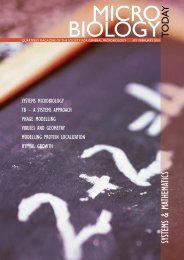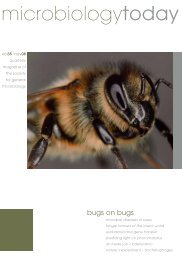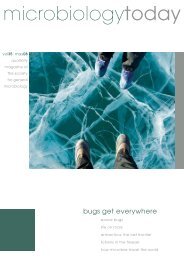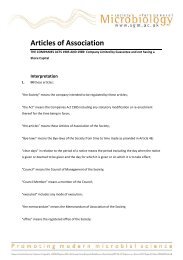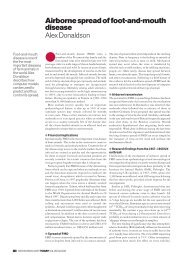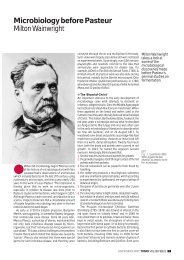Spring Conference 2011 - Society for General Microbiology
Spring Conference 2011 - Society for General Microbiology
Spring Conference 2011 - Society for General Microbiology
Create successful ePaper yourself
Turn your PDF publications into a flip-book with our unique Google optimized e-Paper software.
Please note: Abstracts are published as received from the authors and are not subject to editing.<br />
44<br />
<strong>Spring</strong> Meeting 11–14 April <strong>2011</strong><br />
Harrogate – www.sgmharrogate<strong>2011</strong>.org.uk<br />
SESSION AbSTrACTS<br />
↑Contents<br />
HA08 Cont. & HA09<br />
recognition of paramyxoviruses by pattern recognition receptors<br />
Steve Goodbourn<br />
Biomedical Sciences Research Centre, St George’s, University of London, London SW17 0RE<br />
Paramyxoviruses are conventionally considered good inducers of type i interferons (iFN-α/β). recent studies have focused on the<br />
importance of the cytoplasmic pattern recognition receptor riG-i as a sensor of infection, apparently by recognition of uncapped<br />
5´-triphosphorylated virus-specific rNA molecules. Whilst riG-i is undoubtedly important in inducing iFN production, mda-5 also senses<br />
paramyxovirus infection and is correspondingly activated. The nature of the virus PAMPs that activate riG-i and mda-5 remain unclear,<br />
but our data demonstrate that virus molecules generated by aberrant transcription and/or replication events leading to the production of<br />
defective interfering viruses are the most effective inducers.<br />
Viruses in general mount a major challenge to the iFN system, and paramyxoviruses are no exception. indeed, most paramyxoviruses<br />
encode mechanisms to inhibit both the production of, and response to, type i iFN. The V proteins of many paramyxoviruses limit the<br />
production of iFN-β by direct interaction with mda-5, and the mechanism of this inhibition will be discussed. Since paramyxoviruses also<br />
activate riG-i it is probably necessary <strong>for</strong> these viruses to inhibit riG-i or the downstream consequences of riG-i activation. Our studies<br />
indicate that paramyxoviruses utilise a diverse range of strategies to limit the extent of riG-i activation.<br />
HA09 Food biosecurity<br />
↑Contents<br />
british meat teetering on a knife edge – what’s the value of traditional meat inspection?<br />
ANNETTE NiGSCH1 , Bojan Blagojevic1,2 , Nikolaos Dadios1 , Silvia Alonso1 1 2 Royal Veterinary College, Hawkshead Lane, North Mymms, Hatfield Hert<strong>for</strong>dshire AL9 7TA; Dept of Veterinary Medicine, Faculty of<br />
Agriculture, University of Novi Sad, Serbia<br />
background: Meat inspection (Mi), comprising ante- and post-mortem inspection, represents a fundamental control point <strong>for</strong> the various<br />
hazards associated with the meat production chain. Whereas at the time when Mi was established (19th c.) animal diseases presented with<br />
macroscopic lesions in specific organs of the animal and were easily identifiable during carcase inspection, today new threats have become<br />
more prevalent. While some of these hazards may cause clinical disease on the animal host, many exist sub-clinically.<br />
A debate has started at Eu level: policy makers and stakeholders suggest the traditional Mi system at the slaughterhouse is not fit anymore<br />
to protect the public against these diseases and a radical overhaul and a new way of thinking is necessary.<br />
Project description: To evaluate the risk of missing hazards <strong>for</strong> public health, animal health and animal welfare associated with current Mi<br />
practices a qualitative risk assessment was undertaken. in a second step changes in risk resulting from variation in post-mortem activities<br />
were assessed driven by following questions: a.) how does the risk change if specific carcase parts / organs are no longer inspected; b.)<br />
which alternative steps are suitable to achieve equal levels of protection if the traditional Mi is altered.<br />
Epidemiology of CTX-M ESbL Escherichia coli on cattle farms<br />
N.G. COlDHAM1 , M. Stokes1 , H. Wearing1 , l.C. Snow1 , M. Wootton2 , r.A. Howe2 , C.J. Teale1 1 2 Veterinary Laboratories Agency (Weybridge), New Haw, Addlestone, Surrey KT15 3NB; Specialist Antimicrobial Chemotherapy Unit,<br />
Public Health Wales, <strong>Microbiology</strong> Cardiff, University Hospital Wales, Health Park, Cardiff CF14 4XW<br />
Extended spectrum beta lactamase (ESBl) enzymes are capable of inactivating 3rd and 4th generation cephalosporin antibiotics which are<br />
commonly used in hospitals as front line treatments. A year long passive surveillance study of CTx-M E. coli in a particular study area of<br />
Wales detected CTx-M sequence types 14 (group 9, n=3) and 15 (group 1, n=7) in faeces from cattle and sheep. Geographical analysis<br />
revealed that the CTx-M gene from veterinary sources was widespread. Next, network analysis was used to investigate the dissemination<br />
of CTx-M-14 E. coli from a study farm from which the dairy animals had been sold. The prevalence of CTx-M E. coli in the population of<br />
farms linked by animal movements to this farm was 59% (not significant) compared with 37% in the controls. However, farms which had<br />
used 3rd /4th generation cephalosporin antibiotics were 4 times more likely to have CTx-M E. coli. The veterinary isolates from these studies<br />
were compared to human CTx-M-14 ESBl isolates (n=19) from Wales using a multiplex PCr. This revealed that some CTx-M-14 isolates<br />
from human (n=3 of 19) and veterinary (n=6 of 14) sources shared a plasmid with similar backbone genes.<br />
s o c i e t y f o r g e n e r a l<br />
<strong>Microbiology</strong>



